By Anne Moyer
An experiment conducted by Dutch primatologist Frans de Waal and colleagues recently went viral—search “Capuchin monkeys reject unequal pay” and you will encounter a lively mix of academic articles and social media posts. The video shows a monkey furious that she receives mere cucumbers for completing a task while her neighbor receives attractive grapes. This instance of social inequity aversion in primates is just one example that de Waal employs to explain the basis of human morality in his book The Bonobo and the Atheist: In Search of Humanism Among the Primates. Aside from the obvious humor of watching the small, incensed primate beg the experimenter for grapes, de Waal argues that this research and other ethological experiments are important for understanding the evolution of empathy, altruism, morality, and even religion. By examining the behaviors of bonobos, chimpanzees, and occasionally elephants, de Waal challenges the idea that morality opposes humankind’s most base and selfish urges. Instead, the evolution of morality bolstered the prosocial behavior necessary for mammals to live successfully in groups.
Can science guide morality? Is morality implemented from the top down, to subdue our inherently self-interested natures, or did morality emerge from this very nature? Philosophers and scientists have approached these questions from countless angles, but de Waal posits that the similarities between humans and primates can be exploited to infer the origin of morality. Using the social behaviors of chimpanzees and bonobos, de Waal confronts the “Veneer Theory,” which he defines as a previously dominant view of human nature where a thin veneer of morality hardly disguises our inner and wholly selfish nature. If our genes are entirely selfish, every seemingly altruistic action should benefit our blood relatives or should have a chance for future reciprocity. The author points to numerous examples of humans and primates behaving kindly despite no obvious benefit: from the chimp Daisy making fellow chimp Amos comfortable as he died, to primates adopting unrelated children, to donating blood anonymously, social behaviors frequently involve acting in ways not predicted by the Veneer Theory.
The author allocates a considerable portion of his book to comparing social behaviors among great apes. Although chimpanzees can be aggressive and violent, bonobos are comparatively peaceful. Because humans are about equally related to chimps and to bonobos at the level of DNA, it is reasonable to expect that humans share some of the bonobo’s peaceful tendencies. Furthermore, de Waal argues that apes cannot behave in any way that they please. Instead, these social animals must fit in, obey rules, exhibit empathy, object to unfair interactions, and engage in many other prosocial behaviors. Through easy-to-follow prose and concrete examples, de Waal convincingly and categorically opposes Veneer Theory as a legitimate biological view of human nature.
If morality forms from the bottom-up via social interactions, de Waal argues that religion evolved to enforce prosocial behavior when societal groups became too large to impose rules without the watchful eye of a “supernatural supervisor.” However, he is condemning of Neo-Atheism, claims that science can answer questions of morality, and dogmatism among both scientists and religious adherents. Because of his critical stance, some sections of this book read more like a scholarly debate than a merely explanatory text. The author also deviates from his primary discussion to describe segments of Hieronymus Bosch’s painting, The Garden of Earthly Delights, in each chapter. The author’s connection to the painter’s works is obvious, and rather than detracting from the discussion of morality, de Waal skillfully employs elements of The Garden to bolster his arguments. The historical overview of how opinions of human morality have changed in the last few centuries is excellent, but a more specific description of current opposing views in science could have created a more relevant context for de Waal’s work.
The final chapter of The Bonobo and the Atheist extends the book’s concepts to offer practical suggestions for acknowledging the bottom-up basis of morality. The author mediates a speculative exchange between a bonobo and an atheist, in which the bonobo advises the atheist to stop violently attacking religion and to allow humanism to direct its attention at the more important goal of using humankind’s natural talents to better society. The bonobo suggests focusing on the behaviors of mammals when assessing the morality of humans as social animals, because previous experiments have relied too much on animals lacking the neural circuits required for empathy and altruism. Finally, and most fundamentally, the bonobo and de Waal team up to propose moving past the belief that morality must be enforced from the top down by instead acknowledging that human morality evolves through bottom-up social interactions.
Anna Moyer (ΦBK, University of Alabama, 2014) is in her last year of a dual Bachelor’s/Master’s program at the University of Alabama where she is majoring in biology and minoring in English. The University of Alabama is home to the Alpha of Alabama Chapter of Phi Beta Kappa.




